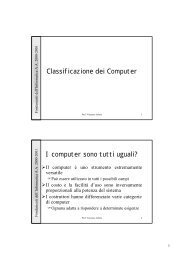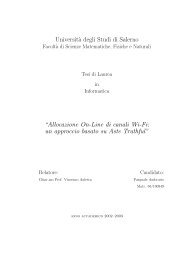Mechanisms for scheduling with single-bit private values
Mechanisms for scheduling with single-bit private values
Mechanisms for scheduling with single-bit private values
Create successful ePaper yourself
Turn your PDF publications into a flip-book with our unique Google optimized e-Paper software.
<strong>Mechanisms</strong> <strong>for</strong> <strong>scheduling</strong> <strong>with</strong> <strong>single</strong>-<strong>bit</strong> <strong>private</strong> <strong>values</strong>Vincenzo Auletta ∗ George Christodoulou † Paolo Penna ‡AbstractDesigning truthful mechanisms <strong>for</strong> makespan minimization in <strong>scheduling</strong> is a class ofproblems that has attracted much interest of researchers over the last decade. It is wellknown that the complexity of this problem is strictly related to the dimension of theagents’ type domain. When machines are unrelated, the domain is multi-dimensional.In this case it is known that truthfulness imposes severe restrictions on feasible algorithms,and impossibility results can be shown. On the other hand, if one restrictsthe input domain to be <strong>single</strong>-dimensional and studies the related machines setting,truthfulness seems to be transparent. In the latter case, minimizing makespan can betruthfully implemented [AT01].Following Lavi and Swamy [LS09], we study a multi-dimensional <strong>scheduling</strong> settingwhere agents’ types are restricted to contain only two possible <strong>values</strong>. Moreover, weassume that <strong>for</strong> each machine jobs are partitioned in two (publicly known) sets whereeach set contain jobs that take the same processing time. In a sense, our setting isthe simplest among the multi-dimensional settings, where each machine holds <strong>private</strong>lyonly a <strong>single</strong>-<strong>bit</strong> of in<strong>for</strong>mation (i.e., which side of the partition contain the good jobs).Our first result shows a separation between truthfulness-in-expectation, and universaltruthfulness <strong>for</strong> this problem; <strong>for</strong> the case where all the machines’ job partitionsare identical we show a way to trans<strong>for</strong>m every algorithm into a randomized truthfulin-expectationmechanism <strong>with</strong> the same approximation guarantee, and there<strong>for</strong>e weshow that optimal truthful-in-expectation mechanisms can be designed. On the otherhand, we show a lower bound on the approximation guarantee of universally truthfulmechanisms.Then we focus on the special case of two machines. We present an optimal truthfulin-expectationmechanism <strong>for</strong> the case where all the machines’ partitions have the samesize and a 3/2–approximation deterministic truthful mechanism <strong>for</strong> the case wherepartitions are unrestricted but publicly known. Finally, we show that if one allowsdomains to contain more than two <strong>values</strong>, a lower bound of 2 can be achieved.∗ Dipartimento di In<strong>for</strong>matica, Università di Salerno, Italy, auletta@dia.unisa.it† Computer Science Department, University of Liverpool, United Kingdom, gchristo@liv.ac.uk‡ Dipartimento di In<strong>for</strong>matica, Università di Salerno, Italy, penna@dia.unisa.it1
1 IntroductionDesigning truthful mechanisms <strong>for</strong> <strong>scheduling</strong> problems was first suggested in the seminalpaper by Nisan and Ronen [NR01], as a paradigm to demonstrate the applicability of MechanismDesign to an optimization problem. In its general <strong>for</strong>m, where the machines areunrelated, there are n jobs to be assigned to m machines. The time needed by a machine ito process job k is described by a nonnegative real value t ik . Given such an input matrix, astandard task from the algorithm designer’s point of view, is to allocate the jobs in a waysuch that some global objective is optimized; a typical objective is to minimize the maximumcompletion time (i.e. the makespan).In a game-theoretic setting, it is assumed that each entry of this matrix is not knownto the designer, but instead it is a <strong>private</strong> value held by a selfish agent that controls themachine. We call this <strong>private</strong> value the agent’s type. The mechanism has to ask each agent<strong>for</strong> her type and the agent can misreport her type to the designer if this is advantageousto her. Mechanism design suggests using monetary compensation to incentivize agents toreport truthfully. Truthfulness is desired, because it facilitates the prediction of the outcomeand at the same time simplifies the agents’ way of reasoning. The challenge is to designtruthful mechanisms that optimize/approximate the makespan.When the entries of the matrix t are unrelated, the type domain <strong>for</strong> each machine i is an n-valued vector t i . For this multi-dimensional domain, the constraints imposed by truthfulnessmake the problem hard. Nisan and Ronen [NR01], showed that it is impossible to design atruthful mechanism <strong>with</strong> approximation factor better than 2, even <strong>for</strong> two machines. Laterthis bound was further improved to 2.41 [CKV09] <strong>for</strong> 3 machines, and to 2.618 [KV12] <strong>for</strong>many machines. In [NR01], it was also shown that applying the VCG mechanism [Vic61,Cla71, Gro73] achieves an approximation ratio of m, and it has been conjectured that thisbound is tight. This conjecture still remains open, but it was further strengthened byAshlagi et al. [ADL12], who proved the conjecture <strong>for</strong> the intuitively very natural case ofanonymous mechanisms (where roughly the allocation algorithm does not base its decisionson the machines’ ids).Randomization provably helps <strong>for</strong> this problem. There are two notions of truthfulness<strong>for</strong> randomized mechanisms. Roughly, a mechanism is universally truthful if it is definedas a probability distribution over deterministic truthful mechanisms, while it is truthful-inexpectation,if in expectation no player can benefit by lying. Already in [NR01], a universallytruthful mechanism was suggested <strong>for</strong> the case <strong>with</strong> two machines. The mechanism wasextended to the case of m machines by Mu’alem and Schapira [MS07] <strong>with</strong> an approximationguarantee of 0.875m, and this was further improved in [LY08a] to 0.837m. Lu and Yu [LY08b]showed a truthful-in-expectation mechanism <strong>with</strong> an approximation guarantee of (m + 5)/2.In [MS07] it was also shown a lower bound of 2 − 1/m, <strong>for</strong> both randomized versions, whilein [CKK10] the lower bound was extended to fractional mechanisms, and an upper boundof (m + 1)/2 was provided.Surprisingly, even <strong>for</strong> the special case of two machines a tight answer on the approximationfactor of truthful randomized mechanisms has not been given. Currently, the lowerbound is 1.5 [MS07], while the best upper bound is 1.5963 due to [LY08b].2
Setting restrictions to the input domain can make the problem easier. The <strong>single</strong>dimensionalcounterpart of the problem is the <strong>scheduling</strong> on related machines. In this case itis assumed that machine i has speed s i and t ik = w k /s i , where the weights w k of the jobs areknown to the designer. Notice that the only in<strong>for</strong>mation missing to the designer is the speedof the machines. Here, the constraints imposed by truthfulness seem harmless; the optimalallocation is truthfully implementable [AT01], although it takes exponential running time,while the best possible approximation guarantee, a PTAS, can be achieved by polynomialtime truthful mechanisms [DDDR11, CK10]. An immediate conclusion is that when onerestricts the domain, then truthfulness becomes less and less stringent.A prominent approach suggested by Lavi and Swamy [LS09], is to restrict the inputdomain, but still keep the multi-dimensional flavour. They assumed that each entry in theinput matrix can take only two possible <strong>values</strong> L, H, that are publicly known to the designer.In this case, a very elegant deterministic mechanism achieves an approximation factor of 2,that is a great improvement comparing to the m upper bound that is the best known <strong>for</strong> thegeneral problem. Surprisingly, even <strong>for</strong> this special case the lower bound is 11/10.1.1 Our contributionThe focus of this work is to study selfish <strong>scheduling</strong> problems on restricted but multidimensionalinput domains <strong>for</strong> which optimized/efficient mechanisms can be given. Following[LS09] we consider domains where each agent’s type can take only one of two possible <strong>values</strong>L, H, <strong>with</strong> L < H, that are publicly known, but we even restrict the way these <strong>values</strong> areplaced in a player input vector. We assume that the designer is given <strong>for</strong> each machine somepublicly known partition of the tasks into two sets such that all jobs in the same set take thesame execution time. Thus, the only in<strong>for</strong>mation missing to the designer is which set of thepartition contains jobs taking time L and which set contains jobs taking time H. There<strong>for</strong>e,the only missing in<strong>for</strong>mation is a <strong>single</strong> <strong>bit</strong> <strong>for</strong> each player 1 . The lower bound given in [LS09]is still valid <strong>for</strong> our setting. It is important to emphasize that all the a<strong>for</strong>ementioned lowerbounds are due to truthfulness, and hold even <strong>for</strong> exponential running time algorithms. Weexplore the effects of truthfulness (both randomized and deterministic) in this restrictedsetting. Our contributions are the following:• Power of truthful-in-expectation mechanisms. There is a class of <strong>scheduling</strong> problemson two-<strong>values</strong> domains <strong>with</strong> publicly known partitions (see Section 1.2) <strong>for</strong> which everyalgorithm (thus including optimal ones) can be turned into a truthful-in-expectationmechanism <strong>with</strong> the same approximation guarantee (Theorem 4). On the contrary,randomized universally truthful mechanisms cannot achieve an approximation betterthan 31/30 (Theorem 22), and the 11/10 lower bound <strong>for</strong> deterministic mechanisms in[LS09] also applies.1 Notice that the in<strong>for</strong>mation missing is just a <strong>single</strong> <strong>bit</strong>, much less than that of the related machines case,where the missing in<strong>for</strong>mation is a positive real number. However, ours is not a <strong>single</strong>-dimensional domain.We refer the reader to Chapter 9 and 12 of [NRTV07] <strong>for</strong> the precise definition of a <strong>single</strong>-dimensionaldomain.3
Notice that such a separation was not known <strong>for</strong> the general problem since, although Lu[Lu09], showed a lower bound higher than 1.5 <strong>for</strong> universally truthful mechanisms, theresult holds only <strong>for</strong> scale-free mechanisms. This is arguably a very natural assumption,but it is still needed to be proven that it is <strong>with</strong>out loss of generality.• <strong>Mechanisms</strong> <strong>for</strong> two machines. For the special case of two machines <strong>with</strong> uni<strong>for</strong>mpartitions (see Section 1.2), we present an exact truthful-in-expectation mechanism(Theorem 18).We also give some evidence that two-vales domains are easier than the general case,even <strong>for</strong> this simple case of two machines. In fact, we show that the lower bound of 2<strong>for</strong> deterministic mechanisms <strong>for</strong> unrelated machines still hold (Theorem 24) when weadmit three–<strong>values</strong> domains while a 3/2–approximation deterministic truthful mechanismsexists <strong>for</strong> two-<strong>values</strong> domains <strong>with</strong> publicly known partitions (Theorem 19), thatare still a restriction of the two-<strong>values</strong> domains).1.2 PreliminariesThe <strong>scheduling</strong> domain. We have n jobs to be scheduled on m machines. Each job mustbe assigned to exactly one machine. In the unrelated-machines setting, each machine i hasa vector of processing times or type t i = (t ih ) h , where t ih ∈ R ≥0 is i’s processing time <strong>for</strong> jobh.In the two-<strong>values</strong> domains by Lavi and Swamy [LS09], the time <strong>for</strong> executing job h onmachine i is either L (low) or H (high), <strong>with</strong> H > L (the case L = H is trivial). Givena partition of the jobs (S, ¯S), we say that machine i is an L S -machine (respectively, H S -machine) if all jobs in S take time L (respectively, H), and all jobs not in S take time H(respectively, L). That is, the type t i of an L S -machine i is such that <strong>for</strong> any job h{ L if h ∈ St ih = L h S :=H otherwiseand similarly <strong>for</strong> H S -machines.In this work, we consider the two-<strong>values</strong> domains <strong>with</strong> publicly known partitions,that are special cases of the two-<strong>values</strong> domains defined in [LS09]. For each machine i we aregiven a (publicly known) subset S i and the <strong>private</strong> in<strong>for</strong>mation is whether i is an L Si -machineor an H Si -machine. Hence, the type t i ∈ {L Si , H Si }. Intuitively, a type t i = L Si indicatesthat machine i is “good” <strong>for</strong> the jobs in S i and “bad” <strong>for</strong> other jobs, while <strong>for</strong> t i = H Siit is the other way around (notice that H Si = L ¯Si where ¯S i = [n] \ S i ). We shall furtherdistinguish between three restrictions (of increasing difficulty) of the domain <strong>with</strong> publiclyknown partitions:1. identical partitions, where all subsets S i are identical;2. uni<strong>for</strong>m partitions, where all subsets S i have size s <strong>for</strong> some s ≥ 0;4
3. (unrestricted) publicly known partitions, which impose no restriction on thesubsets S i .We say that job h is an L-job (respectively, H-job) <strong>for</strong> machine i if t ih = L (respectively,t ih = H), <strong>with</strong> t i being the type of machine i. We represent an allocation by a matrixx = (x ih ), where x ih ∈ {0, 1} and x ih = 1 iff job h is assigned to machine i (since every jobis assigned to exactly one machine, ∑ i x ih = 1).Given an allocation x and machine types t, we define the load of machine i as the set ofjobs allocated to i in x and denote byC i (x, t) := ∑ hx ih t ihthe cost of machine i. The makespan of x <strong>with</strong> respect to t is the maximum cost of anymachine, i.e., max i C i (x, t).An exact or optimal allocation is an allocation that, <strong>for</strong> the given input t, minimizesthe makespan. A c-approximation is an allocation whose makespan is at most c times thatof the optimal allocation. A deterministic algorithm A outputs an allocation x = A(t).For a randomized algorithm A rand , A rand (t) is a probability distribution over all possibleallocations; we call A rand (t) a randomized allocation.Mechanism design. In order to characterize truthful mechanisms, we consider the allocationsthat are given in output <strong>for</strong> two inputs which differ only in one machine’s type. Welet (ˆt i , t −i ) denote the vector (t 1 , . . . , t i−1 , ˆt i , t i+1 , . . . , t m ) obtained from t by replacing t i <strong>with</strong>ˆt i .Given types t and a job allocation x, we count the number of L-jobs and the number ofH-jobs allocated to machine i in x:n i L(x, t) := |{h : t ih = L and x ih = 1}|,n i H(x, t) := |{h : t ih = H and x ih = 1}|.Definition 1 (monotone algorithm). An algorithm A is monotone (in expectation) if, <strong>for</strong>any machine i and <strong>for</strong> any two inputs that differ only in one machine’s type, t = (t i , t −i )and ˆt = (ˆt i , t −i ), the following inequality holds (in expectation):n i L − n i H + ˆn i L − ˆn i H ≥ 0 (1)where n i L = ni L (A(t), t), ni H = ni H (A(t), t), ˆni L = ni L (A(ˆt), ˆt), and ˆn i L = ni L (A(ˆt), ˆt).By applying [LS09, Proposition 5.7] to our two-<strong>values</strong> domains <strong>with</strong> publicly knownpartitions, we obtain that truthfulness is equivalent to the monotonicity condition above:Theorem 2. For the case of two-<strong>values</strong> domains <strong>with</strong> publicly known partitions, there existprices P such that the mechanism (A, P ) is truthful (in expectation) iff A is monotone (inexpectation).5
Throughout the paper, we refer to the quantity n i L (x, t) − ni H (x, t) as the unbalance ofmachine i in the allocation x <strong>with</strong> respect to type t. We also refer to the quantity in (1) asthe overall unbalance of machine i. For any instance t, <strong>for</strong> any two machines i and j, and<strong>for</strong> any α, β ∈ {L, H}, we consider the subset of jobs whose execution time is α on machinei and β on machine j:J ijαβ (t) := {h : t ih = α and t jh = β}.1.3 An illustrative exampleWe begin <strong>with</strong> an example and show how we can use randomization to design optimalmonotone-in-expectation algorithms from deterministic algorithms in the case of two-<strong>values</strong>domains <strong>with</strong> identical partitions.Consider the following instances along <strong>with</strong> their optimal allocation (gray box), and thequantities n i L − ni H <strong>for</strong> each of the two machines (numbers outside the box):2 2555 552 2555-3 45 155 2 25555 5 2 2 2 2 2 5 5 2 2 2 2 2552 2555 555 522222 5 5222220 1 -2 4 (2)Let machine 1 and machine 2 correspond to top and bottom machine, respectively. Observethat the monotonicity condition (1) is violated <strong>for</strong> machine i = 2 by looking at the twomiddle instances (they differ in the machine connected by dotted line). Indeed, the quantityin (1) is 1 − 2 = −1. Alternatively, we can swap the allocation in the first and in the thirdinput:04-212 2555 552 255555 2 25555 5 2 2 2 2 2 5 5 2 2 2 2 255-3 152 2555 555 522222 5 5222224 (3)Now, however, the monotonicity condition is violated by machine i = 1 <strong>for</strong> the last twoinstances. These instances have been used by Lavi and Swamy [LS09] to prove their lowerbound <strong>for</strong> deterministic mechanisms. However, if we choose randomly between the allocationin (2) and the one in (3) <strong>with</strong> the same probability, the corresponding optimal randomizedalgorithm satisfies monotonicity in expectation (<strong>for</strong> example, in the first instance the unbalancebecomes −3/2 <strong>for</strong> both machines, while in the second instance it remains unchanged).Fact 3. For two machines and two-<strong>values</strong> domains <strong>with</strong> identical partitions as above, <strong>with</strong><strong>values</strong> L = 2 and H = 5, no truthful mechanism can achieve an approximation factor betterthan 1.1 [LS09]. On the contrary, <strong>for</strong> the same problem there exists an exact truthful-inexpectationmechanism.In the sequel we show that this positive result holds in general <strong>for</strong> some of our domains,and not only in the very special instance where deterministic mechanisms cannot be optimal.6
2 Identical partitionsIn this section we consider the case of machines <strong>with</strong> identical partitions and give a general(“black box”) method to convert <strong>scheduling</strong> deterministic algorithms into mechanisms thatare truthful-in-expectation. The main result of this section is summarized by the followingtheorem.Theorem 4. Every deterministic algorithm A <strong>for</strong> <strong>scheduling</strong> jobs on machines <strong>with</strong> identicalpartitions can be turned into a randomized mechanism M which is truthful-in-expectation andsuch that the allocation returned by M has makespan no greater than the one returned by A.Let (S, ¯S) be a partition of the jobs, <strong>with</strong> |S| = s and | ¯S| = n − s, such that <strong>for</strong> eachmachine i we have S i = S. Without loss of generality we can reorder the jobs in such a waythat S = {1, 2, . . . , s} and ¯S = {s + 1, s + 2, . . . , n}. Since the partition of the jobs is public,the only in<strong>for</strong>mation that is <strong>private</strong> to each machine is which side of the partition containsits L-jobs. Thus, the type’s domain of each machine contains only two elements:L S = (L · · · LH · · · · · · H) and H S = (H · · · HL · · · · · · L)For any instance t, we denote by m S (t) and m ¯S(t) the number of L S -machines andH S -machines in t, respectively. Clearly, m S (t) + m ¯S(t) = m. Given an allocation x, it isconvenient to count, <strong>for</strong> each side of the partition, the number of jobs that are scheduled inx as L-jobs:l S (x, t) = |{h ∈ S : ∃i such that x ih = 1 and t ih = L}| (4)l ¯S(x, t) = |{h ∈ ¯S : ∃i such that x ih = 1 and t ih = L}| (5)and l(x, t) := l S (x, t) + l ¯S(x, t) is the overall number of jobs allocated in x as L-jobs.Following the idea described in Section 1.3, we show now how to obtain a randomizedallocation from a deterministic one by randomly “shuffling” machines of the same type:Definition 5. For any deterministic allocation x, we denote by x (rand) the randomized allocationobtained from x as follows:• Pick an integer r ∈ {0, . . . , m S −1} uni<strong>for</strong>mly at random, and set x (rand)i<strong>for</strong> each L S -machine i;• Pick an integer ¯r ∈ {0, . . . , m ¯S −1} uni<strong>for</strong>mly at random, and set x (rand)i<strong>for</strong> each H S -machine i.:= x i+r mod mS:= x i+¯r mod m ¯SFor any deterministic algorithm A, we let A (rand) be the randomized algorithm that, on inputt, returns the randomized allocation x (rand) where x = A(t).Notice that l S (x (rand) , t) = l S (x, t) and l ¯S(x (rand) , t) = l ¯S(x, t). In the following discussionwe fix x and t and simply write l S and l ¯S.7
For any L S -machine i, its expected load consists of n i L = l S/m S L-jobs and n i H =(n − s − l ¯S)/m S H jobs. Thus the expected unbalance of an L S -machine isn i L − n i H = l S − (n − s − l ¯S)m S=l − (n − s)m S.Similarly, the expected load of an H S -machine i consists of n i L = l ¯S/m ¯S L-jobs and n j H =(s − l S )/m ¯S H-jobs and its expected unbalance is equal ton i L − n i H = l ¯S − (s − l S )m ¯S= l − s .m ¯SLemma 6. Algorithm A (rand) is monotone-in-expectation if the deterministic algorithm A issuch that <strong>for</strong> any t = (L S , t −i ) and ˆt = (H S , t −i ), it holds thatl − (n − s)m S+ ˆl − sm ¯S + 1 ≥ 0 (6)where l = l(A(t), t) and ˆl = l(A(ˆt), ˆt) denote the number of L-jobs allocated by A on inputt and ˆt, respectively.Proof. Consider two instances t = (L S , t −i ) and ˆt = (H S , t −i ). By the previous discussionwe have that, <strong>for</strong> any i, the total unbalance of machine i isn i L − n i H + ˆn i L − ˆn i H =l − (n − s)m S+ ˆl − sˆm ¯Swhere ˆm ¯S is the number of H S -machines in ˆt. Since ˆm ¯S = m ¯S + 1, then (6) is equivalent to(1) and, by Definition 1, A (rand) is monotone-in-expectation.2.1 Canonical allocationsLemma 6 says that in order to design an exact truthful-in-expectation mechanism <strong>for</strong> two<strong>values</strong>domains <strong>with</strong> identical partitions it is sufficient to design a deterministic exact algorithmwhich satisfies the condition in (6). We now show that this is always possible by takingany exact algorithm A and trans<strong>for</strong>ming the allocations computed by A into “canonical” allocations.Intuitively, canonical allocations are allocations where it is not possible to swapjobs between two machines and increase the number of allocated L-jobs <strong>with</strong>out increasingthe makespan of the allocation. These allocations can be obtained from any allocation byrepeatedly swapping jobs according to local rules (specified below). We will show that eachof these swap operations increase the number of allocated L-jobs, <strong>with</strong>out increasing themakespan.To this end, we extend our previous notation.8
n ij n jiHL LH{}}{{}}{ijL···L···H···H ··· L···LL···L···H ··· H ··· H ··· HH···HH···HL ··· LL···LijL···L···H···H ··· L···LL···L···H ··· H ··· H ··· HH···HH···HL ··· LL···LFigure 1: The swapping Rule R2 in the definition of canonical allocation.Definition 7. Given an instance t and an allocation x, <strong>for</strong> any α, β ∈ {L, H} and <strong>for</strong> anytwo machines i and j, we let n ijαβ(x, t) be the number of α-jobs that are allocated to machinei and that are β-jobs <strong>for</strong> machine j:n ijαβ (x, t) := |{k : x ik = 1, t ik = α,and t jk = β}|.Notice that n ijαβis different from njiβαbecause the first index denotes the machine thatgets the jobs. We can now define our canonical allocations.Definition 8 (canonical allocation). A canonical allocation (<strong>for</strong> the instance t) is an allocationobtained by modifying a deterministic allocation x as follows:1. Apply the following Rule R1 until possible: Suppose jobs h and k are allocated tomachines i and j, respectively (x ih = 1 = x jk ). If t ik ≤ t ih and t jh < t jk (i.e.,no machine gets worse and at least one gets better if we swap the two jobs amongthe machines i and j), then move job h to machine j and job k to machine i (setx ik = x jh = 1 and x ih = x jk = 0).2. Apply the following Rule R2 until possible: If n ij HL(x, t) > njiLH(x, t) and j gets onlyjobs from J jiLH (t), then move nij ijHLjobs in JHL (t) from i to j, and move njiLHjobs in(t) from j to i (see Figure 1.).J jiLHFact 9. Both Rules R1 and R2 decrease the overall number of H-jobs by at least one. Thus,given x and t, it is possible to compute in polynomial time a canonical allocation x ′ (followingthe two steps in Definition 8) whose cost is not larger than the cost of x.2.2 A black-box construction (proof of Theorem 4)We can assume <strong>with</strong>out loss of generality that our deterministic algorithm always returnscanonical allocations (Remark 9). The following two lemmas provide important structuralproperties of such canonical allocations.Lemma 10. Every allocation x that is canonical <strong>with</strong> respect to the instance t is such thateither l S (x, t) = s or l ¯S(x, t) = n − s.9
Proof. Suppose by absurd that l S (x, t) < s and l ¯S(x, t) < n − s. Then, in the allocation xthere exists a job h ∈ S that is assigned to an H S -machine i and a job l ∈ ¯S that is assignedto an L S -machine j. Since t ih = H and t jl = H while t jh = L and t il = L then it is possibleto apply Rule R1 to jobs j and l. But this contradicts the hypothesis that x is canonical<strong>with</strong> respect to t.Lemma 11. If the allocation x is canonical <strong>with</strong> respect to the instance t then we have that:1. If l S (x, t) = s then l ¯S(x, t) ≥ m ¯Sm· (n − s);2. If l ¯S(x, t) = n − s then l S (x, t) ≥ m Sm · s.Proof. We prove only point 1 (proof of point 2 being similar).Let x be an allocation that is canonical <strong>with</strong> respect to t and such that l S (x, t) = s.Since l ¯S(x, t) is equal to the number of jobs in ¯S that are allocated to H S -machines thenthere are n − s − l ¯S(x, t) jobs of ¯S that are allocated to L S -machines (i.e. they are allocatedas H-jobs). There<strong>for</strong>e, there must be an L S -machine i and an H S -machine j such that i getsat least (n − s − l ¯S(x, t))/m S jobs from ¯S (and all these jobs are bad <strong>for</strong> i but good <strong>for</strong> j)and j gets at most l ¯S(x, t)/m ¯S jobs from ¯S (they are good <strong>for</strong> j but bad <strong>for</strong> i). Then, wehaven ij HL ≥ n − s − l ¯S(x, t)m S. (7)andn jiLH ≤ l ¯S(x, t). (8)Observe now that since by hypothesis l S (x, t) = s, we have that j gets only jobs from ¯Sand, since x is canonical then, by point 2 of Definition 8, it must be n ij HL ≤ nji LH. Thus, thefollowing inequality holds:l ¯S(x, t)≥ n − s − l ¯S(x, t)(9)m ¯Sm Sfrom which we obtain thatl ¯S(x, t) · (1/m S + 1/m ¯S) = l ¯S(x, t) · m/(m S · m ¯S) ≥ (n − s)/m S ,m ¯Sand thusl ¯S(x, t) ≥ (n − s) · m ¯Sm .We can now give a black-box construction to trans<strong>for</strong>m any deterministic algorithm intoa randomized and monotone-in-expectation one that has no worse makespan.Theorem 4. Let A be a deterministic <strong>scheduling</strong> algorithm and let A ′ be the algorithm thatfirst calls A to compute an allocation and then trans<strong>for</strong>ms this allocation into a canonicalone. We observe that the canonization process described in Definition 8 does not increase10
the makespan of the allocation. Thus, by Theorem 2 and Lemma 6, to prove the theoremit is sufficient to show that <strong>for</strong> any t = (L S , t −i ) and ˆt = (H S , t −i ) such that x = A ′ (t) andˆx = A ′ (ˆt)l − (n − s)m S+ˆl − sm − m S + 1 ≥ 0where l is the number of L-jobs allocated in x and ˆl is the number of L-jobs allocated in ˆx.Because of Lemma 10 there are only four cases to consider:1. (l S = s and ˆl ¯S = n − s.) Observe that l + ˆl ≥ n. There<strong>for</strong>el − (n − s) ˆl − s+m S m − m S + 1≥=≥ 0.l − (n − s) + ˆl − smax{m S , m − m S + 1}l + ˆl − nmax{m S , m − m S + 1}2. (l ¯S = n − s and ˆl S = s.) Also in this case l + ˆl ≥ n. The rest of the proof goes likethe previous case.3. (l S = s and ˆl S = s.) Since m ¯S = m − m S and ˆm ¯S = m ¯S + 1, by Lemma 11, we havethatl ¯S ≥ m − m Sm · (n − s) and ˆl ¯S ≥ m ¯S + 1 · (n − s).mHencel − (n − s) ˆl − s+m S m − m S + 1 = s + l ¯S − (n − s)+ s + ˆl ¯S − sm S m ¯S + 1≥s + m−m Sm≥s − n − sm S m≥ 0.· (n − s) − (n − s)m S++ n − smm ¯S+1 (n − s)mm ¯S + 14. (l ¯S = n − s and ˆl ¯S = n − s.) This case follows by symmetry <strong>with</strong> the previous case(simply exchange S <strong>with</strong> ¯S).3 <strong>Mechanisms</strong> <strong>for</strong> two machinesIn this section we consider <strong>scheduling</strong> on two-<strong>values</strong> domains <strong>with</strong> publicly known partitionsin the case of m = 2 machines. In particular, we give an exact truthful-in-expectation mechanism<strong>for</strong> the case <strong>with</strong> uni<strong>for</strong>m partitions (Sect. 3.1) and a deterministic 3/2-approximationmechanism <strong>for</strong> the case of (nrestricted) publicly known partitions (Sect. 3.2).11
3.1 An exact truthful-in-expectation mechanismAs in the case of identical partitions, we show that every exact algorithm can be turned intoan exact monotone-in-expectation algorithm (by Theorem 2 this implies an exact truthfulin-expectationmechanism). Also in this case we restrict ourselves to <strong>scheduling</strong> algorithmsthat give in output only canonical allocations (this is <strong>with</strong>out loss of generality by Fact 9)and obtain monotonicity-in-expectation by randomizing among several exact allocations.However, since the partitions are not identical, the randomization procedure will be appliedonly to some of the canonical allocations.Consider the four possible inputs and let us represent them as the following simple graphwhere two inputs are adjacent if and only if they differ in exactly the type of one machine:canonicalL S1L S2canonicalL S1H S2randomizedL S1L S2canonicalL S1H S2H S1L S2H S1H S2H S1L S2H S1H S2canonicalcanonicalcanonicalrandomizedFigure 2: The strategy to obtain randomized monotone allocations <strong>for</strong> two machines: eachnode corresponds to a possible input and only two out of the four canonical allocations arerandomized.Note that the monotonicity condition (1) involves only inputs that are adjacent in thisgraph. Our strategy is to prove that monotonicity is satisfied at every edge. To this aim, wedefine two classes of allocations and prove that all canonical allocations are in one of thesetwo classes. We then show that the randomization procedure guarantees monotonicity <strong>for</strong>canonical allocations in each of the two possible classes.Definition 12 (allocation classes). An allocation x is classified <strong>with</strong> respect to the instancet as• i-restricted if machine i gets only a proper subset of the jobs in J ijLH(t), where j ≠ idenotes the other machine;• symmetric if, <strong>for</strong> any i ∈ {1, 2} and j ≠ i, machine i gets all jobs in J ijLH(t), no jobin J ijij ijHL(t), and a (possibly empty) subset of the jobs in JLL (t) ∪ JHH (t).We say that x is restricted if it is 1-restricted or 2-restricted.The following lemma proves that all exact canonical allocations belong to one of theclasses defined in Definition 12.12
ij··· L······ L······ L······ H······ H······ L······ H······ H···ij··· L······ L······ L······ H······ H······ L······ H······ H···i-restricted allocationssymmetric allocationsFigure 3: The two allocation classes of Definition 12.Lemma 13. Every exact canonical allocation x <strong>with</strong> respect to an instance t is either symmetricor restricted.Proof. Let x be an exact canonical allocation <strong>with</strong> respect to instance t. We remark that, bydefinition, JLH 12212112(t) = JHL (t) and JLH (t) = JHL (t). This fact follows directly from Definition 8.Fact 14. If the swapping Rule R1 cannot be applied to an allocation x <strong>with</strong> respectto t, then there is at most one machine i such that n ij HL(x, t) > 0, <strong>with</strong> j ≠ i. Inthis case, machine j gets only jobs from the set J jiLH (t).There<strong>for</strong>e it is not possible that in the allocation x machine 1 gets some jobs from JHL 12 (t)and machine 2 gets some jobs from JHL 21 (t). Observe that if neither machine gets such jobsthen the allocation x is of class symmetric (see Definition 12). Thus, we have only to provethat in all the other cases in the allocation x there is a machine i that gets only a subset ofjobs in J ijLH (t).Suppose first that machine 1 gets some jobs from JHL 12 (t) and machine 2 gets no jobsfrom JHL 212112(t). This means that all jobs in JHL (t) = JLH (t) are allocated to machine 1. Toconclude that the solution is of class 2–restricted, it is sufficient to show that all jobs inJ LL (t) ∪ J HH (t) are allocated to machine 1. But, this is true since if machine 2 would get ajob ¯h ∈ J LL (t)∪J HH (t) then it would be possible to apply Rule-R1 (see Definition 8) to swap¯h <strong>with</strong> a job h ∈ JHL 12 (t), thus contradicting the hypothesis that the allocation is canonical.Similarly, we have that if machine 2 gets some jobs from JHL 21 (t) and machine 1 gets nojobs from JHL 12 (t), then the solution if of class 1–restricted.The following two technical lemmas give bounds on the number of jobs allocated tomachines in exact allocations.Lemma 15. In any exact allocation <strong>for</strong> an instance t, if there is at least one job that can beassigned as L-job to one of the two machines (i.e., there is at least a machine i and a job ksuch that t ik = L), then no machine gets more than ⌊n/2⌋ H-jobs.Proof. Consider the allocation in which machine i gets job k and any subset of ⌊n/2⌋ otherjobs, and the other machine j gets all the remaining n − (⌊n/2⌋ + 1) = ⌊n/2⌋ jobs. Themakespan of this allocation is at most L + ⌊n/2⌋H < H + ⌊n/2⌋H = ⌈n/2⌉H. That is, anyallocation that assigns more than ⌊n/2⌋ H-jobs cannot be an exact allocation because it haslarger makespan.13
S 1{}}{L L HHswapLL}{{}swapHHS 1{}}{H H LLswapHH}{{}swapLLS 2S 2instance (L S1 ,L S2 ) instance (H S1 ,H S2 )Figure 4: Swapping operation to obtain allocation y from the symmetric allocation x.Lemma 16. If an instance t admits an exact allocation of class i–restricted then machine igets at least n/2 jobs in J ijijLH(t), <strong>with</strong> i ≠ j. This implies that |JLH (t)| > n/2.Proof. Let x be an exact i–restricted allocation, <strong>for</strong> some i ∈ {1, 2}. By Definition 12,machine i gets in x only a proper subset of the jobs in J ijLH(t) and machine j gets at leastone H-job. Then, n i L (x, t) = nijLH (x, t) and ni H (x, t) = 0. Since x is an exact allocation,i must get more jobs than j, otherwise a new allocation <strong>with</strong> smaller makespan could beobtained by moving one job in J ijLH (t) from j to i. Thus, ni L (x, t) > n/2. To conclude theproof observe that n i ijL (x, t) = nijLH(x, t) < |JLH (t)|, where the inequality is strict because igets in x only a proper subset of the jobs in J ijLH (t).We remark that in order to prove the monotonicity condition in (1) we would like tohave allocations that have large unbalance. The following lemma says that, <strong>for</strong> two of thefour possible inputs, exact canonical allocations can be converted into exact randomizedallocations having a “good” expected unbalance on both machines.Lemma 17. For every deterministic exact canonical allocation x <strong>for</strong> an instancet ∈ {(L S1 , L S2 ), (H S1 , H S2 )}<strong>with</strong> uni<strong>for</strong>m partitions (i.e. |S 1 | = |S 2 |), there exists a randomized allocation x (rand) whichgives an expected unbalance of n − |J 2 HH (t)| to both machines and has makespan equal to x.Proof. Since the partitions are uni<strong>for</strong>m, the subsets JLH 1212(t) and JHL (t) have the same sizes − |S 1 ∩ S 2 |in both instances (see Figure 4). This implies that allocation x must be symmetric, <strong>for</strong>otherwise we would have one of the two subsets JLH 1221(t) or JLH (t) <strong>with</strong> more than n/2elements (Lemma 13 and Lemma 16), which cannot be because they have the same size andthey are disjoint.Since allocation x is symmetric, we can build a new allocation y by swapping jobs inJ 12LL12(t) and in JHH (t) between the two machines (see Figure 4).H-jobs is now exchanged between the two machines, that isn 1 H(y, t) = n 2 H(x, t) and n 2 H(y, t) = n 1 H(x, t).14Clearly, the number of
Since |JLH 1212(t)| = |JHL (t)|, the same happens <strong>with</strong> respect to the L-jobs, that isn 1 L(y, t) = n 2 L(x, t) and n 2 L(y, t) = n 1 L(x, t).This means that y has the same makespan as x. Moreover, if we pick at random <strong>with</strong>probability 1/2 between allocation x and allocation y, in the resulting randomized allocationx (rand) , the expected number of L-jobs assigned to any of the two machines is equal ton 1 L (x, t) + n2 L (x, t)= n − |J HH (t)| ,22while the expected number of H-jobs is equal ton i H (x, t) + nj H(x, t)2= |J HH (t)| .2The expected unbalance of each machine is thus n/2 − |J HH (t)|. Clearly, since y and x havethe same makespan, the makespan of x (rand) is the same as the same makespan of x.We are now in a position to prove the main result of this section:Theorem 18. For m = 2 machines there exists an exact truthful-in-expectation mechanism<strong>for</strong> <strong>scheduling</strong> on two-<strong>values</strong> domains <strong>with</strong> uni<strong>for</strong>m partitions.Proof. Let A be any exact deterministic algorithm <strong>for</strong> <strong>scheduling</strong> on two machines that givesin output only canonical allocations. We can define a randomized exact algorithm which firstcomputes x = A(t), and then replaces x by the randomized allocation x (rand) of Lemma 17in two out of the four possible input instances (see Figure 4):{xA (rand) (rand)if t ∈ {(L(t) :=S1 , L S2 ), (H S1 , H S2 )}x if t ∈ {(H S1 , L S2 ), (L S1 , H S2 )}By Lemma 17, A (rand) is also an exact algorithm. So, we only need to prove that themonotonicity condition in (1) holds in expectation (Theorem 2).Observe that any two instances t = (t i , t −i ) and ˆt = (ˆt i , t −i ) that differ only on the typeof one machine i correspond to a pair of adjacent nodes in the graph in Figure 4. We canthus assume <strong>with</strong>out loss of generality that t denotes the instance <strong>for</strong> which A (rand) returns arandomized allocation x (rand) and ˆt denotes the instance <strong>for</strong> which it return a deterministicexact canonical allocation ˆx,t ∈ {(L S1 , L S2 ), (H S1 , H S2 )} and ˆt ∈ {(L S1 , H S2 ), (H S1 , L S2 )}.Consider the overall expected unbalance of machine i,UN i := n i L − n i H + ˆn i L − ˆn i H (10)where n i L = ni L (x(rand) , t), n i H = ni H (x(rand) , t), ˆn i L = ni L (ˆx, ˆt) and ˆn i H = ni H (ˆx, ˆt). ByLemma 17, we know that n i L − ni H = n/2 − |J HH (t)| and thusUN i = n/2 − |J HH (t)| + ˆn i L − ˆn i H.To show that this quantity is positive we distinguish two cases:15
(ˆx is i–restricted) Machine i gets no H-jobs (Definition 12) and at least n/2 L-jobs (byLemma 16), which means thatˆn i L − ˆn i H ≥ n/2thus implyingUN i ≥ n/2 − |J HH (t)| + n/2= n − |J HH (t)|≥ 0.(ˆx is not i–restricted) By Lemma 13, allocation ˆx is either symmetric or j–restricted <strong>with</strong>j ≠ i. In both cases, machine i gets all jobs in J ijLH (ˆt). Since ˆt ∈ {(L S1 , H S2 ), (H S1 , L S2 )}and because the partitions have uni<strong>for</strong>m size, in instance ˆt there is at least one jobthat can be assigned as an L-job to one of the two machines. Thus, by Lemma 15, inallocation ˆx machine i gets at most n/2 H-jobs. There<strong>for</strong>e we haveˆn i L − ˆn i H ≥ |J ijLH (ˆt)| − n/2.Observe that J ijLH (ˆt) = J ijHH(t), which impliesUN i ≥ n/2 − |J HH (t)| + |J HH (t)| − n/2= 0.We have thus shown that A (rand) is monotone in expectation.3.2 A deterministic 3/2-approximation truthful mechanismNow we switch to deterministic mechanisms and we prove the following result:Theorem 19. For m = 2 machines there exists a 3/2-approximation deterministic truthfulmechanism <strong>for</strong> <strong>scheduling</strong> <strong>for</strong> two-<strong>values</strong> domains <strong>with</strong> (unrestricted) publicly known partitions.In order to prove this result we exhi<strong>bit</strong> a monotone 3/2-approximation algorithm. Wewere unable to extend the mechanism <strong>for</strong> the case of three or more machines so this is leftas a natural open problem.The algorithm.On input t, the algorithm partitions the jobs into three subsets:J LL (t), J HH (t) and J LHHL (t) := J 12LH(t) ∪ J 12HL(t)First, allocates jobs in J LHHL (t), and then completes the allocation by dividing “evenly” theother jobs in J LL (t) and in J HH (t). Some careful “tie breaking rule” must be used here todeal <strong>with</strong> the case in which some of these subsets of jobs have odd cardinality.The algorithm consists of the following two steps (in the sequel we do not specify theinput “t”):16
1. Step 1 (allocate jobs in J LHHL ) We allocate these jobs depending on the class ofthe canonical exact allocation (see Definition 12) <strong>for</strong> all jobs:(a) (class i–restricted. Compute a canonical exact allocation <strong>for</strong> J LHHL .(b) (class symmetric). Assign all jobs in J LHHL as L-jobs.We denote by JLHHL i the set of jobs that are assigned to machine i in this first step,and let C (LHHL)i be the corresponding cost of machine i.2. Step 2 (allocate jobs in J LL and J HH ) For a set of jobs S and a nonnegative integerq, we denote by ⌊S/q⌋ and ⌈S/q⌉ an ar<strong>bit</strong>rary subset of S of cardinality ⌊|S|/q⌋ and⌈|S|/q⌉, respectively. We define the set J i of all jobs that are assigned to machine i atthe end of this step (which includes the jobs JLHHL i assigned in the previous step) asfollows: For i and j satisfying C (LHHL)i ≥ C (LHHL)j , we allocate to i the set⎧ ⌊ ⌋ ⌈ ⌉JLHHL ⎪⎨i ∪ JHH JLL∪ if both |J2 2LL | and |J HH | are odd;J i :=⌊ ⌋ ⌊ ⌋⎪⎩ JLHHL i ∪ JHH JLL∪ otherwise,2 2and thus machine j gets the rest of the jobsJ j := ¯J i = [n] \ J i .Approximation guarantee. The two steps of the algorithm keep a small difference betweenthe completion times of the two machines as is <strong>for</strong>mally demonstrated in the following:Lemma 20. After each step, the difference between the two completion times is at most theoptimum, that ismax C (LHHL)ii ≤ OP T and maxiC i ≤ miniC i + OP T.Proof. As <strong>for</strong> the first part, let J LHHL be not empty (otherwise the statement trivially holds).Recall that there are two cases <strong>for</strong> the allocation of jobs in J LHHL . In the first case (canonicalexact is not symmetric) the algorithm allocates J LHHL identically to the exact allocation onthis set, and there<strong>for</strong>e the statement holds. In the second case (canonical exact is symmetric),the algorithm allocates all jobs as L-jobs. This is exactly what the exact allocation does, sothe statement follows.For the second statement, if the machine <strong>with</strong> higher C (LHHL)i controls the makespan,17
and both J LL , J HH have odd size, thenmax C i = max C (LHHL)i +i i≤≤min C (LHHL)i⌊JHH2⌋H +⌊JHHi + OP T +2⌈ ⌉JHHH +2min C (LHHL)i +i= miniC i + OP T,while if not both J LL , J HH are odd,max C i = max C (LHHL)i +i i≤≤⌊JHHmin C (LHHL)i + OP T +imin C i + OP T.iFinally, if the machine <strong>with</strong> lower C (LHHL)imax C i ≤ mini i≤≤C (LHHL)i +max C (LHHL)i +imin C i + OP T.i22⌋H +⌊JHH2⌈JLL⌉L2⌋H +⌊JLL2⌊JLL⌈JLL⌉L2⌋L + OP T⌋L2⌋H +⌊JLL2⌋Ldetermines the makespan, then⌊ ⌋ ⌊ ⌋JHH JLLH + L + H2 2⌊ ⌋ ⌊ ⌋JHH JLLH + L + H2Then we prove the 3/2-approximation guarantee by distinguishing the two cases in Step 1of the algorithm (allocation of jobs in J LHHL ) which correspond to the class of the canonicalexact allocation <strong>for</strong> the whole instance.(class 1–restricted or 2–restricted). Recall that an allocation of class 2–restricted assignsa proper subset of these jobs to machine 2, thus implying that machine 1 must get atleast one H-job from this set. (The case of the solution <strong>for</strong> the class 1–restricted is similar).There<strong>for</strong>eOP T ≥ OP T 1 ≥ |J LL |L + |J HH |H + H.On the other hand, by using Lemma 20, we obtain2AP X = 2 max C i ≤ C 1 + C 2 + H = |J LL |L + |J HH |H + C (LHHL)1 + C (LHHL)2 + H ≤ 3OP T.i18
(class symmetric). Let g LL and g HH denote the number of jobs from J LL and J HH thatthe optimum assigns to machine 1, respectively. This gives the following lower bound on theoptimum (the costs of the two machines):and thus (by summing up)OP T ≥ g LL L + g HH H + |JLH|L12OP T ≥ (J LL − g LL )L + (J HH − g HH )H + |JLH|L212OP T ≥ |J LL |L + |J HH |H + (|J LH | + |J HL |)L.In this scenario, our algorithm assigns all jobs in J LHHL = JLH 12 ∪ J LH 21two costs satisfyC (LHHL)1 + C (LHHL)2 = |JLH|L 12 + |JHL|L.12There<strong>for</strong>eas L-jobs and thus the2AP X = 2 max C i ≤ C 1 + C 2 + H = |J LL |L + |J HH |H + C (LHHL)1 + C (LHHL)2 + Hi≤ |J LL |L + |J HH |H + H + 2OP T − |J LL |L − |J HH |H ≤ 3OP T,and hence the approximation guarantee has been shown <strong>for</strong> both cases.Fact 21. It is easy to verify that the mechanism can indeed reach a 3/2 approximationguarantee on the following instance |J LL | = 2, |J HH | = 1, |J LHHL | = 0, <strong>with</strong> H = 2L. Theoptimal makespan is 2L, while the makespan of the algorithm is 3L.Monotonicity. First observe that the algorithm assigns to machine i at least half (roundedup or down) of its L-jobs in t, and at most half (rounded up or down) of its H-jobs in t. Inparticular,⌈ ⌉ ⌊ ⌋⌊ ⌋ ⌈ ⌉n ijLH ≥ J ijLH, n ijLL2≥ J ijLLand n ij HL2≤ J ijHL, n ij HH2≤ J ijHH.2For the jobsets J LL and J HH this is immediate. Now, let us consider the jobset J ijLH (theother case is symmetric). If we are in the symmetric case, the algorithm assigns all thesejobs to i. Otherwise, the algorithm computes the canonical optimum on J LHHL . Supposethat n ijLH < ⌈ J ijLH2⌉. Optimality implies that machine i gets at least one H job from the setJ ijHL. But then the allocation is not canonical (nor optimal) since Rule 2 of Definition 8 canbe applied. There<strong>for</strong>e we obtain⌈ ⌉ ⌊ ⌋⌈ ⌉ ⌊ ⌋n i J ijLHJ ijLLL ≥ + , n i J ijHHJ ijHLH ≤ + . (11)2 22 2Second, observe that if the type of machine i flips from t i to ˆt i , then |Ĵ ij ijᾱβ| = |Jαβ | (here¯L = H and ¯H = L). Applying (11) <strong>for</strong> both t i , ˆt i and using the last identity, we finallyobtain (1).19
4 Lower bounds and separation resultsThe next theorem says that truthful-in-expectation mechanisms are provably more powerfulthan universally truthful mechanisms. Indeed, <strong>for</strong> this problem version, exact truthfulin-expectationmechanism exist <strong>for</strong> any number of machines (see Theorem 4). The proofcombines the idea of the lower bound by Lavi and Swamy [LS09] <strong>with</strong> the use of Yao’sMin-Max Principle suggested by Mu’alem and Schapira [MS07].Theorem 22. No universally truthful mechanism can achieve an approximation factor betterthan 31/30 <strong>for</strong> <strong>scheduling</strong> on two machines, even <strong>for</strong> the case of identical partitions.Proof. A universally truthful mechanism is simply a probability distribution over deterministictruthful mechanisms [NR01]. A lower bound on the approximation ratio of any universallytruthful mechanism can be obtained via Yao’s Min-Max Principle as illustrated in[MS07]: find a probability distribution over all possible inputs such that every deterministicmechanism (monotone algorithm) has an expected approximation guarantee of c or worse.Example 23 (two-machines identical partitions). We have the four inputs in the examplein Section 1.3. We know that any deterministic algorithm must err on at least one of thesefour inputs and this implies that (because of the <strong>values</strong>) on this input the approximation is10/9 ≈ 1.111 (the deterministic lower bound). Taking the uni<strong>for</strong>m distribution over thesefour inputs, Yao’s principle tells us that every universally truthful mechanism must have an(expected) approximation which is not better than (1/4) · (10/9) + 3/4 = 37/36 ≈ 1.0277.The previous bound can be improved by optimizing the probability distribution. Inparticular, we assign positive probabilities only to three out of the four inputs shown here:probability p 1 − 2p p5522222 5522222 2255555input2255555 5522222 5522222APX of alternative allocation 10/9 11/10 10/9(12)Every deterministic monotone algorithm must change the output in at least one of thesethree inputs (because monotonicity is not satisfied between the first two inputs and betweenthe last two). Deterministic algorithms that use an alternative allocation in the first (or thethird) input have an expected approximation at leastp · (10/9) + (1 − p) = 1 + p/10while <strong>for</strong> those algorithms that use an alternative allocation in the second input, the approximationis at least(1 − 2p)11/10 + 2p = 1 + 1/10 − 2p/10Taking p = 1/3 we equate these two quantities and thus obtain that every deterministicalgorithm must have an approximation of at least 31/30 ≈ 1.0333. There<strong>for</strong>e Yao’s Min-Max Principle yields Theorem 22.20
Lower bounds <strong>for</strong> three-<strong>values</strong> domains. The above bounds can be strengthened byconsidering three-<strong>values</strong> domains (which are no-longer “<strong>single</strong>-<strong>bit</strong>”). First, we give an alternativeproof <strong>for</strong> the lower bound of 2 <strong>for</strong> deterministic mechanisms on two machines, firstshowed by Nisan and Ronen in [NR01]. The proof in [NR01] requires that the input domainconsists of at least 4 different <strong>values</strong>. Here, we extend the proof in order to hold even whenthe domain consists of 3 different <strong>values</strong>.Theorem 24. For two machines and the case in which the processing times can take three<strong>values</strong>, no (deterministic) truthful mechanism can achieve an approximation factor betterthan 2.Proof. Assume that we have only two machines and an odd number of jobs, that is n = 2k+1.For every machine i and job h, the processing time can only take the following three <strong>values</strong>t ih ∈ {0, 1, 1 + ɛ}.Let us assume that the input is t ih = 1, <strong>for</strong> all machines i, and <strong>for</strong> all jobs h. Let x = A(t)be the allocation matrix determined by the mechanism M = (A, P ). If one of the machinesgets all the jobs then the algorithm has makespan 2k + 1, while the opt has makespan k + 1,and so the approximation ratio can be ar<strong>bit</strong>rarily close to 2 <strong>for</strong> large ar<strong>bit</strong>rarily large <strong>values</strong>of k. If the jobs are allocated to both machines, let j be the machine that gets a subset S jof jobs <strong>with</strong> odd cardinality. Now produce the following input ˆt by changing the type of jonly:⎧⎨ˆt ih =⎩0, i = j and h ∈ S j1 + ɛ, i = j and h ∉ S jt ih , otherwiseLet ˆx = A(ˆt), be the allocation <strong>for</strong> the input ˆt. Because the mechanism is truthful, it shouldalso be monotone (see e.g. [CKV09]):∑h∈S j(t jh − ˆt jh ) · (x jh − ˆx jh ) ≤ 0.From this we get that the subset of jobs that machine j gets <strong>for</strong> the input ˆt is also S j . Themakespan of the mechanism <strong>for</strong> the input ˆt is ∣ ∣ ¯Sj∣ ∣, where ¯Sj = [n] \ S j , while the optimalmakespan is ∣ ∣ ¯Sj∣ ∣ /2.We next strengthen the lower bound on universally truthful mechanisms of Theorem 22 byconsidering domains of three <strong>values</strong>. The proof consists of a suitable probability distributionover the instances used <strong>for</strong> the deterministic lower bound.Theorem 25. No universally truthful mechanism can achieve an approximation factor betterthan 9/8 <strong>for</strong> <strong>scheduling</strong> on two machines and three jobs that take three <strong>values</strong>.Proof. There are three jobs and t is the matrix <strong>with</strong> all processing times equal 1. Besidesthe two allocations which assign all jobs to one machine, there are 6 non-trivial allocations:111111· · ·111111(13)21
We next show that every deterministic monotone algorithm which gives one of these allocationscannot have an approximation better than 2. Consider a modified instance <strong>for</strong> each ofthese allocations:ɛδδ111· · ·where δ = 1 + ɛ and ɛ is a some tiny number. Every monotone deterministic algorithmwhich chooses one of the allocations in (14) is <strong>for</strong>ced to output the corresponding allocationin (14) (this is the same as in the proof of Theorem 24 when considering three jobs). Theapproximation is then 2/(1 + ɛ) which, <strong>for</strong> tiny ɛ, gets ar<strong>bit</strong>rarily close to 2.Assign a probability p to each of the instances in (14) and probability q = (1 − 6p) tothe instance of all 1’s. Every deterministic algorithm which allocates all jobs to the samemachine has expected approximation at least111δδɛq(3/2) + 1 − q = 1 + q/2 = 1 + 1/2 − 3pwhile every deterministic monotone algorithm using on of the allocations in (13) has expectedapproximation at least2p + 1 − p = 1 + pTaking p = 1/8 these two quantities are equal and thus every deterministic monotone algorithmhas an expected approximation at least 9/8. Yao’s Min-Max Principle implies thatthis lower bound applies to every universally truthful mechanism.5 ConclusionIn this paper we studied <strong>scheduling</strong> on selfish machines <strong>for</strong> two-<strong>values</strong> input domains <strong>with</strong>publicly known partitions. We considered three different models of publicly known partitionsand presented both exact randomized truthful-in-expectation and approximation determinisitcmechanisms and proved some lower bounds.Our work leaves several open questions. First of all, we are able to derive exact truthfulin-expectationmechanisms <strong>for</strong> an ar<strong>bit</strong>rary number of machines only in the case wherepartitions where identical. Moreover, exact truthful-in-expectation mechanisms <strong>for</strong> two machinesare given only <strong>for</strong> uni<strong>for</strong>m partitions. A natural opne question is whether it’s possibleto extend the result to more general cases like (1) any number of machines <strong>with</strong> uni<strong>for</strong>mpartitions, or (2) two machines <strong>with</strong> unrestricted given partitions? Finally we note that thelower bound of 2 <strong>for</strong> three-<strong>values</strong> domains does not consider jobs’ partitions (as our upperbounds do) and thus it would be natural/interesting to prove a lower bound <strong>for</strong> three-<strong>values</strong>domains <strong>with</strong> publicly known partitions.Acknowledgements. Part of this work was done while the second author was at theMax-Planck Institute <strong>for</strong> In<strong>for</strong>matics, Saarbrücken, and while visiting the Università diSalerno. Research of the first and third author partially supported by the PRIN 2008 researchproject COGENT (COmputational and GamE-theoretic aspects of uncoordinatedNeTworks), funded by the Italian Ministry of University and Research.22(14)
References[ADL12][AT01][CK10][CKK10][CKV09]Itai Ashlagi, Shahar Dobzinski, and Ron Lavi. Optimal lower bounds <strong>for</strong> anonymous<strong>scheduling</strong> mechanisms. Mathematics of Operations Research, 37(2):244–258, 2012.Aaron Archer and Éva Tardos. Truthful mechanisms <strong>for</strong> one-parameter agents.In Proc. of the 42nd IEEE Symposium on Foundations of Computer Science(FOCS), pages 482–491, 2001.George Christodoulou and Annamária Kovács. A deterministic truthful PTAS<strong>for</strong> <strong>scheduling</strong> related machines. In Proc. of the 21st ACM-SIAM Symposium onDiscrete Algorithms (SODA), pages 1005–1016. SIAM, 2010.George Christodoulou, Elias Koutsoupias, and Annamária Kovács. Mechanismdesign <strong>for</strong> fractional <strong>scheduling</strong> on unrelated machines. ACM Transactions onAlgorithms, 6(2), 2010.George Christodoulou, Elias Koutsoupias, and Angelina Vidali. A lower bound<strong>for</strong> <strong>scheduling</strong> mechanisms. Algorithmica, 55(4):729–740, 2009.[Cla71] Edward H. Clarke. Multipart pricing of public goods. Public Choice, 8, 1971.[DDDR11] Peerapong Dhangwatnotai, Shahar Dobzinski, Shaddin Dughmi, and TimRoughgarden. Truthful approximation schemes <strong>for</strong> <strong>single</strong>-parameter agents.SIAM J. on Computing, 40(3):915–933, 2011.[Gro73] Theodore Groves. Incentives in teams. Econometrica, 41(4):617–631, 1973.[KV12] Elias Koutsoupias and Angelina Vidali. A lower bound of 1+φ <strong>for</strong> truthful<strong>scheduling</strong> mechanisms. Algorithmica, pages 1–13, 2012.[LS09] Ron Lavi and Chaitanya Swamy. Truthful mechanism design <strong>for</strong> multidimensional<strong>scheduling</strong> via cycle monotonicity. Games and Economic Behavior,67(1):99 – 124, 2009.[Lu09] Pinyan Lu. On 2-player randomized mechanisms <strong>for</strong> <strong>scheduling</strong>. In Proc. ofthe 5th International Workshop on Internet and Network Economics (WINE),volume 5929 of Lecture Notes in Computer Science, pages 30–41. Springer, 2009.[LY08a][LY08b]Pinyan Lu and Changyuan Yu. An improved randomized truthful mechanism<strong>for</strong> <strong>scheduling</strong> unrelated machines. In 25th Annual Symposium on TheoreticalAspects of Computer Science (STACS), volume 1 of LIPIcs, pages 527–538, 2008.Pinyan Lu and Changyuan Yu. Randomized truthful mechanisms <strong>for</strong> <strong>scheduling</strong>unrelated machines. In 4th International Workshop on Internet and NetworkEconomics (WINE), pages 402–413, 2008.23
[MS07]Ahuva Mu’alem and Michael Schapira. Setting lower bounds on truthfulness. InProceedings of the 18th ACM-SIAM Symposium on Discrete Algorithms (SODA),pages 1143–1152, 2007.[NR01] Noam Nisan and Amir Ronen. Algorithmic mechanism design. Games andEconomic Behavior, 35:166–196, 2001.[NRTV07] Noam Nisan, Tim Roughgarden, Éva Tardos, and Vijay V. Vazirani. AlgorithmicGame Theory. Cambridge University Press, 2007.[Vic61]William Vickrey. Counterspeculations, auctions and competitive sealed tenders.Journal of Finance, 16:8–37, 1961.24
















